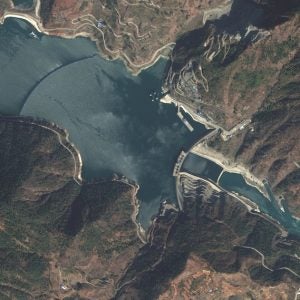AT THE International RCC Dams Seminar held in Colorado, US, in October 2002, sixteen experts from the US and Australia provided a blend of the old and the new with respect to RCC dam design, construction and quality control. The week-long structured training course attracted a capacity attendance of 43 from seven countries.
Course director Kenneth D Hansen pointed out that lessons learned from some pioneering early RCC dam designs included the need for water-stopped transverse contraction joints and more impermeable upstream faces for RCC dams. Upper Stillwater dam in Utah completed 15 years ago was designed without joints and has experienced some uncontrolled cracking repair. In order to better control thermal related cracking, Hansen felt both precooling of the RCC and strategically located transverse joints are required. While a quite low maximum placing temperature may be technically desirous, its cost can be quite high. Therefore, the challenge facing the design engineer is to achieve a balance between the cost of cooling and additional transverse joints.
Terry Arnold of MWH Global noted that the upstream face needed to be a part of an overall seepage control system that can include the RCC itself, waterstopped joints, drains and a collection system. Arnold presented updated charts of unit seepage measured at some existing RCC dams. It showed that more recent designs incorporating conventional concrete placed concurrently with the RCC were performing better than earlier designs and seepage reduced with time Slipformed concrete faces that included sealed joints as well as membrane faced precast concrete panel systems were also shown to produce low and acceptable seepage values.
Shear resistance and direct tensile strength at lift lines continues to be the major item of concern in the design of high RCC dams, especially in earthquake-prone areas according to Brain Forbes of GHD in Australia. Use of the sloping layer method of placing RCC that was developed in China was presented as a proven method for increasing cohesion by reducing the exposure time between placing successive RCC layers. This placing method increased RCC placement rates on several large RCC dams, Forbes noted. Mortar bedding and retarded high-paste mixes were also discussed as methods for improving bond between RCC layers.
Forbes further talked on unlocking the secret on how to properly produce grout-enriched RCC (GERCC) faces as initial attempts at using GERCC in the US have fallen somewhat short. Proper production of a GERCC face generally requires a low Vebe time RCC mixture with a medium to high cementious content prior to introduction of a not too thick a grout. A super plasticizering admixture will aid reducing the water-cement ratio of the grout while still maintaining its relatively wet consistency. A measured seepage of only one l/sec through the GERC face at the 131m Jiangya dam in China was reported by Forbes.
Hansen, in his presentation on tests for RCC quality control noted that the Vebe consistency test had a variable accuracy with low Vebe times being more accurate. He also noted that the preparation of RCC test cylinders using a vibrating hammer ( Hilti gun or Kango hammer) has become the most accepted method. In addition, there is evidence that there is a relationship between a Vebe time and the time for the vibrating hammer to develop mortar around its head in that the Vebe time is 2 to 2.5 times the ‘Hilti gun’ time. Using the vibrating hammer may be a quick way to determine an approximate Vebe time in the field without the need for a vibrating table.
Presentations by contractors played an important part in the seminar and study tour that followed the classroom instruction. Jeff Allen of ASI-RCC, Kevin Ellerton of Barnard Construction, Tom Webber of Thalle Construction as well as Carlo Anamasi of Kiewit Pacific shared their experience in building RCC dams with the attendees.
The highlight of the six-dam study tour was viewing RCC placement at the 97m high Olivenhain dam, the highest RCC dam in the US. Located north of San Diego, Olivenhain is the 39th RCC dam in the US higher than 15m. Other RCC dams completed in 2002 include the high Hunting Run dam in Virginia and Randleman dam in North Carolina. Both are 30m high water-supply dams.
The study tour visited Olivenhain just 10 days before completion of placement of 1,089,000m3 RCC two months ahead of schedule. RCC was placed at record rates at Olivenhain. A world record of 220,025m3 was placed in one month (June 2002) and a US record of 12,195m3 in one day.
Saluda dam in South Carolina is the next major RCC dam to be built and will be constructed between the existing semi-hydraulic fill embankment and its hydroelectric plant. Harold Moxley of South Carolina Electric and Gas reported placement of the RCC by Barnard Construction Co is scheduled to start in August 2003 and continue through the end of 2004.
The next similar International RCC Dams Seminar and Study Tour is planned for September 2004, with Saluda as a possible tour stop.
Related Articles
Spotlight on…RCC






